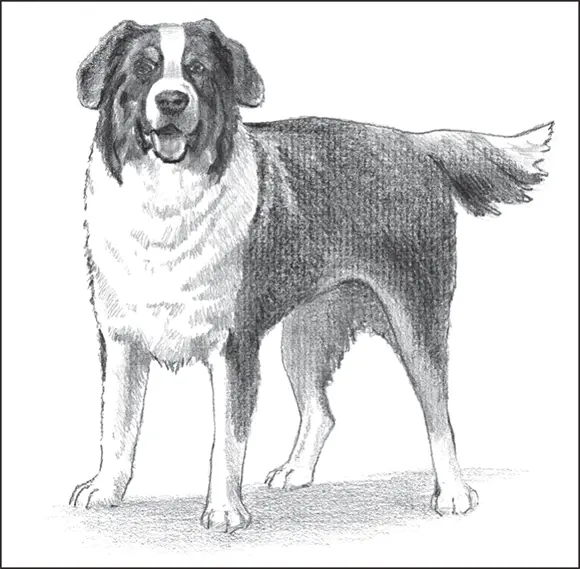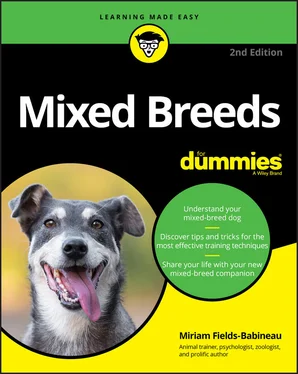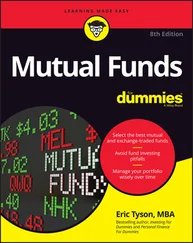1 ...7 8 9 11 12 13 ...17 
Illustration by Barbara Frake
FIGURE 2-8:The Bordernese looks very much like a larger Border Collie with the added tan highlights over the eyes.
Both breeds were developed as herding dogs. Therefore, both are very intelligent and easy to train. The difference in temperament lies in the Border Collie being a higher-energy worker than the Bernese Mountain Dog and also far more sensitive. Border Collies generally don’t interact well with children, whereas the Bernese Mountain Dog adores children.
 Mixing these two breeds together creates a larger herding dog with a medium energy level and fairly outgoing personality. However, Bernese Mountain Dogs don’t have the same longevity of a Border Collie, so the hybrid offspring may not either. Another issue with mixing these two breeds together is that both are prone to the same genetic defects such as hip and elbow dysplasia, eye problems, and heart problems. Border Collies also might have horrendous allergic reactions to flea bites, as well as epilepsy. The hybrid offspring are highly likely to not have good hybrid vigor.
Mixing these two breeds together creates a larger herding dog with a medium energy level and fairly outgoing personality. However, Bernese Mountain Dogs don’t have the same longevity of a Border Collie, so the hybrid offspring may not either. Another issue with mixing these two breeds together is that both are prone to the same genetic defects such as hip and elbow dysplasia, eye problems, and heart problems. Border Collies also might have horrendous allergic reactions to flea bites, as well as epilepsy. The hybrid offspring are highly likely to not have good hybrid vigor.
Chapter 3
A Little of This, a Little of That: Deciding Which Mixed Breed Is Right for You
IN THIS CHAPTER
 Discovering whether you’re ready for a dog
Discovering whether you’re ready for a dog
 Looking at the different breeds
Looking at the different breeds
 Considering age and gender
Considering age and gender
Bringing a dog into your home is a big deal. Sure, they’re all adorable and hard to resist. But before you fall for those puppy-dog eyes, you need to ask yourself some serious questions: Am I ready for a dog? Which dog is the right one for me? Do I want a puppy or an adult dog? Male or female? Big or small? In this chapter, you discover the answers to all these questions and more.
Asking Yourself the Right Questions
Before you can start thinking about which dog you want, you need to ask yourself whether you’re ready to even have a dog in the first place. A dog is a commitment.
There are several very important questions you need to ask yourself. If you can honestly answer yes to all of them, then a mixed-breed dog is right for you and your family.
Do you have enough time for a dog?
Notice I asked this question first? Being a dog guardian isn’t just about playing with your dog when you want to — it’s about caring for him 24/7, walking him, feeding him, grooming him, training him, making sure he gets the right veterinary care. A dog is not a piece of furniture to be cast aside when you get too involved in your busy life. He’s a living, needy, interactive, sentient being who craves your companionship. Unless you’re able to give a dog all the time he needs, you shouldn’t get one.
Do you have enough money for a dog?
Adoption fees generally range from $40 to $150. A designer dog can cost anywhere from $1,000 to $6,000! But the actual amount it takes to walk out the door with a dog in your arms is not the bulk of what your dog will cost. You also need to consider daily, monthly, and yearly expenses of dog ownership. You’ll need to buy food, bedding, and toys. A small dog may be easy to handle at only $5 per week in kibble, but what if he requires a special diet? Many dogs have food allergies or physical ailments, requiring prescription diets; these can run upwards of $20 per week, depending on the size of your mixed breed. Obviously, the larger and/or more active the dog, the more food he’ll need to eat.
You’ll need to pay to have your dog groomed; the more you can do yourself, the less it’ll cost, but if you send your dog to a professional groomer, you’ll be paying anywhere from $60 to $300 (per visit) for the service.
You may decide to enroll your dog in obedience classes or other training; basic training lessons can cost anywhere from $120 for a set of group classes to more than $3,000 for boarding and training.
And you’ll need to see a vet at least once a year — more if your dog gets sick or is injured. A quick trip to the vet is rarely less than $50; it normally costs well over $100 just for the checkup and yearly vaccinations. Plus, there are the monthly expenses of parasite control, at about $60 per month. As your dog gets older or is injured, there are the costs of medications to consider. Some medical treatments can range into thousands of dollars.
Are you ready to give your heart to a dog?
Let’s say that you do have the time and money for a mixed-breed dog. Are you ready to love one? There’s far more to having a dog than merely taking care of his needs. The emotional attachments will affect you for a lifetime. Along with all the fun you have, there will also be stress and sadness. Are you ready to fill your heart with love, only to suffer the eventual heartbreak of loss 10 or 12 years down the road when your dog dies?
 Even though the pain of losing a dog is awful, all the years of fun and joy you have with your dog are worth it — as long as you know what you’re getting into. If the idea of losing a pet you love is too much for you to bear, you’re better off not getting one.
Even though the pain of losing a dog is awful, all the years of fun and joy you have with your dog are worth it — as long as you know what you’re getting into. If the idea of losing a pet you love is too much for you to bear, you’re better off not getting one.
Looking at the Different Breeds
Each dog breed was developed for specific tasks — guarding, herding, hunting, hand-warming — and these breeds are grouped together by their original purpose. A mixed breed is a combination of two or more breeds. Knowledge of the appearance and personalities of the various breed groups will help you understand your own dog, and will also be useful if you’re thinking about which type of mixed breed to get.
On the hunt: The Sporting Group
Sporting dogs were bred to aid hunters in locating, retrieving, and flushing game. They can track, chase, freeze, and return with the prize. Two of the most popular dogs in the United States — the Labrador Retriever and the Golden Retriever (see Figure 3-1) — belong to this group. Sporting dogs make great hunting companions and fantastic pets; and they’re great with active families. They need a lot of exercise and stimulation (see Chapter 9for more on how much exercise the Sporting Group needs).
The AKC recognizes 26 breeds in the Sporting Group. The most popular breeds in this group — and the ones most often seen in mixed-breed dogs — include: Brittany, Chesapeake Bay Retriever, Cocker Spaniel, English Setter, English Springer Spaniel, German Shorthaired Pointer, Golden Retriever, Irish Setter, Labrador Retriever, Pointer, Vizsla, and Weimaraner.

Illustration by Barbara Frake
FIGURE 3-1:The ever-popular Golden Retriever is just one example of dogs in the Sporting Group.
Читать дальше


 Mixing these two breeds together creates a larger herding dog with a medium energy level and fairly outgoing personality. However, Bernese Mountain Dogs don’t have the same longevity of a Border Collie, so the hybrid offspring may not either. Another issue with mixing these two breeds together is that both are prone to the same genetic defects such as hip and elbow dysplasia, eye problems, and heart problems. Border Collies also might have horrendous allergic reactions to flea bites, as well as epilepsy. The hybrid offspring are highly likely to not have good hybrid vigor.
Mixing these two breeds together creates a larger herding dog with a medium energy level and fairly outgoing personality. However, Bernese Mountain Dogs don’t have the same longevity of a Border Collie, so the hybrid offspring may not either. Another issue with mixing these two breeds together is that both are prone to the same genetic defects such as hip and elbow dysplasia, eye problems, and heart problems. Border Collies also might have horrendous allergic reactions to flea bites, as well as epilepsy. The hybrid offspring are highly likely to not have good hybrid vigor. Discovering whether you’re ready for a dog
Discovering whether you’re ready for a dog Even though the pain of losing a dog is awful, all the years of fun and joy you have with your dog are worth it — as long as you know what you’re getting into. If the idea of losing a pet you love is too much for you to bear, you’re better off not getting one.
Even though the pain of losing a dog is awful, all the years of fun and joy you have with your dog are worth it — as long as you know what you’re getting into. If the idea of losing a pet you love is too much for you to bear, you’re better off not getting one.











